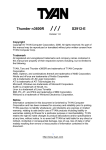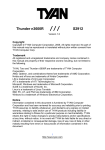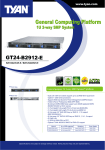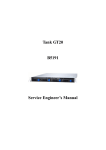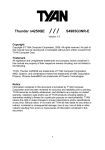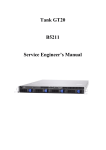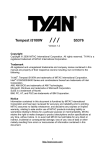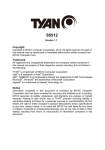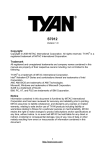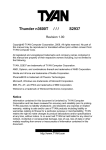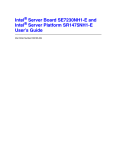Download Tyan Transport GT24
Transcript
Transport GT24 B2912 Service Engineer’s Manual PREFACE Copyright This publication, including all photographs, illustrations, and software, is protected under international copyright laws, with all rights reserved. Neither this manual, nor any material contained herein, may be reproduced without written consent of the manufacturer-. Copyright 2006 Version 1.0 Disclaimer Information contained in this document is furnished by TYAN Computer Corporation and has been reviewed for accuracy and reliability prior to printing. TYAN assumes no liability whatsoever, and disclaims any express or implied warranty, relating to sale and/or use of TYAN products including liability or warranties relating to fitness for a particular purpose or merchantability. TYAN retains the right to make changes to product descriptions and/or specifications at any time, without notice. In no event will TYAN be held liable for any direct or indirect, incidental or consequential damage, loss of use, loss of data or other malady resulting from errors or inaccuracies of information contained in this document. Trademark Recognition All registered and unregistered trademarks and company names contained in this manual are property of their respective owners including, but not limited to the following. TYAN and Transport GT24 B2912 are trademarks of TYAN Computer Corporation. AMD, Opteron, and combinations thereof are trademarks of AMD Corporation. Nvidia and nForce are trademarks of Nvidia Corporation. LSI is a trademark of LSI Logic Corporation. ATI is a trademark of ATI Technologies Inc. Microsoft, Windows are trademarks of Microsoft Corporation. SuSE is a trademark of Novell, Inc. Linux is a trademark of Linus Torvalds. IBM, PC, AT, PS/2 are trademarks of IBM Corporation. Winbond is a trademark of Winbond Electronics Corporation. Portable Document Format (PDF) is a trademark of Adobe Corporation. i Federal Communications Commission (FCC) Notice for the USA Compliance Information Statement (Declaration of Conformity Procedure) DoC FCC Part 15: This device complies with part 15 of the FCC Rules Operation is subject to the following conditions: 1) This device may not cause harmful interference, and 2) This device must accept any interference received including interference that may cause undesired operation. If this equipment does cause harmful interference to radio or television reception, which can be determined by turning the equipment off and on, the user is encouraged to try one or more of the following measures: – Reorient or relocate the receiving antenna. – Increase the separation between the equipment and the receiver. – Plug the equipment into an outlet on a circuit different from that of the receiver. Consult the dealer on an experienced radio/television technician for help. Notice for Canada This apparatus complies with the Class B limits for radio interference as specified in the Canadian Department of Communications Radio Interference Regulations. (Cet appareil est conforme aux norms de Classe B d’interference radio tel que specifie par le Ministere Canadien des Communications dans les reglements d’ineteference radio.) Notice for Europe (CE Mark) This product is in conformity with the Council Directive 89/336/EEC, 92/31/EEC (EMC). CAUTION: Lithium battery included with this board. Do not puncture, mutilate, or dispose of battery in fire. Danger of explosion if battery is incorrectly replaced. Replace only with the same or equivalent type recommended by manufacturer. Dispose of used battery according to manufacturer instructions and in accordance with your local regulations. ii About this Manual This manual provides you with instructions on installing your Transport GT24, and consists of the following sections: Chapter 1: Provides an Introduction to the Transport GT24 B2912 barebones, packing list, describes the external components, gives a table of key components, and provides block diagrams of the system. Chapter 2: Covers procedures on installing the CPU, memory modules, an optional PCI card, and hard drives. Chapter 3: Covers removal and replacement procedures for pre-installed components. Appendix: Describes the differences between mainboard BIOS and system BIOS. The cable connection tables are also provided for reference of system setup. Conventions The following conventions are used in the manual: Note: Calls attention to important information. Warning: P r o v i d e s i n f o r m a t i o n t o p r e v e n t h a r m to user or damage to equipment. iii SAFETY INFORMATION Before installing and using the Transport GT24, take note of the following precautions: – Read all instructions carefully. – Do not place the unit on an unstable surface, cart, or stand. – Do not block the slots and opening on the unit, which are provided for ventilation. – Only use the power source indicated on the marking label. If you are not sure, contact the Power Company. – The unit uses a three-wire ground cable, which is equipped with a third pin to ground the unit and prevent electric shock. Do not defeat the purpose of this pin. If your outlet does not support this kind of plug, contact your electrician to replace your obsolete outlet. – Do not place anything on the power cord. Place the power cord where it will not be in the way of foot traffic. – Follow all warnings and cautions in this manual and on the unit case. – Do not push objects in the ventilation slots as they may touch high voltage components and result in shock and damage to the components. – When replacing parts, ensure that you use parts specified by the manufacturer. – When service or repairs have been done, perform routine safety checks to verify that the system is operating correctly. – Avoid using the system near water, in direct sunlight, or near a heating device. – Cover the unit when not in use. iv Table of Contents Chapter 1:Overview 1.1 1.2 1.3 1.4 1.5 About the TYAN Transport GT24 B2912 . . . . . . . . . . . . . . . . . . . 1 Product Models . . . . . . . . . . . . . . . . . . . . . . . . . . . . . . . . . . . . . . . . 2 Features . . . . . . . . . . . . . . . . . . . . . . . . . . . . . . . . . . . . . . . . . . . . . . 3 Unpacking . . . . . . . . . . . . . . . . . . . . . . . . . . . . . . . . . . . . . . . . . . . . 5 About the Product . . . . . . . . . . . . . . . . . . . . . . . . . . . . . . . . . . . . . . 7 1.5.1 System Front View . . . . . . . . . . . . . . . . . . . . . . . . . . . . . . . 7 1.5.2 System Rear View . . . . . . . . . . . . . . . . . . . . . . . . . . . . . . . . 7 1.5.3 LED Definition . . . . . . . . . . . . . . . . . . . . . . . . . . . . . . . . . . 8 1.5.4 System Internal View. . . . . . . . . . . . . . . . . . . . . . . . . . . . . 10 1.5.5 Motherboard (S2912) Block Diagram . . . . . . . . . . . . . . . . 12 1.5.6 S2912 Board Parts, Jumpers, and Connectors . . . . . . . . . . 14 Chapter 2:Setting Up 2.1 2.2 2.3 2.4 2.0.1 Before You Begin . . . . . . . . . . . . . . . . . . . . . . . . . . . . . . . 17 2.0.2 Work Area . . . . . . . . . . . . . . . . . . . . . . . . . . . . . . . . . . . . . 17 2.0.3 Tools . . . . . . . . . . . . . . . . . . . . . . . . . . . . . . . . . . . . . . . . . 17 2.0.4 Precautions. . . . . . . . . . . . . . . . . . . . . . . . . . . . . . . . . . . . . 18 Rack Mounting . . . . . . . . . . . . . . . . . . . . . . . . . . . . . . . . . . . . . . . 19 2.1.1 Installing the Server in a Rack. . . . . . . . . . . . . . . . . . . . . . 19 Installing Motherboard Components. . . . . . . . . . . . . . . . . . . . . . . 24 2.2.1 Removing the Chassis Cover. . . . . . . . . . . . . . . . . . . . . . . 24 2.2.2 Installing the CPU, Heatsink, and Air Duct. . . . . . . . . . . . 25 2.2.3 Installing the Memory . . . . . . . . . . . . . . . . . . . . . . . . . . . . 28 2.2.4 Installing a PCI-E Card . . . . . . . . . . . . . . . . . . . . . . . . . . . 30 Installing the Hard Drive for GT24-B2912. . . . . . . . . . . . . . . . . . 32 Installing the Slim FDD (Option) . . . . . . . . . . . . . . . . . . . . . . . . . 34 Chapter 3:Replacing Pre-Installed Components 3.1 3.2 3.3 3.4 3.5 3.6 Introduction . . . . . . . . . . . . . . . . . . . . . . . . . . . . . . . . . . . . . . . . . . 37 3.1.1 Work Area . . . . . . . . . . . . . . . . . . . . . . . . . . . . . . . . . . . . . 37 3.1.2 Tools . . . . . . . . . . . . . . . . . . . . . . . . . . . . . . . . . . . . . . . . . 37 3.1.3 Precautions. . . . . . . . . . . . . . . . . . . . . . . . . . . . . . . . . . . . . 38 Disassembly Flowchart . . . . . . . . . . . . . . . . . . . . . . . . . . . . . . . . . 39 Removing the Cover . . . . . . . . . . . . . . . . . . . . . . . . . . . . . . . . . . . 40 Replacing Motherboard Components . . . . . . . . . . . . . . . . . . . . . . 41 3.4.1 Disconnecting All Motherboard Cables . . . . . . . . . . . . . . 41 3.4.2 Removing the Motherboard . . . . . . . . . . . . . . . . . . . . . . . . 42 Replacing the Slim DVD-ROM . . . . . . . . . . . . . . . . . . . . . . . . . . 43 Replacing the LED Control Board . . . . . . . . . . . . . . . . . . . . . . . . 45 v 3.7 3.8 3.9 3.6.1 M1003 LED Control Board Features. . . . . . . . . . . . . . . . . 47 3.6.2 M1003 LED Control Board Connector Pin Definition . . . 48 Replacing the M1012 Adapter Board . . . . . . . . . . . . . . . . . . . . . . 49 3.7.1 M1012 Adapter Board Features. . . . . . . . . . . . . . . . . . . . . 50 3.7.2 M1012 Adapter Board Connector Pin Definition . . . . . . . 51 Replacing the SAS/SATA Backplane. . . . . . . . . . . . . . . . . . . . . . 56 3.8.1 SAS/SATA Backplane (M1208) Features. . . . . . . . . . . . . 58 Replacing the Power Supply . . . . . . . . . . . . . . . . . . . . . . . . . . . . . 60 Appendix I: BIOS Differences Appendix II: Cable Connection Tables Appendix III: Installing SMDC Card Technical Support vi Chapter 1: Overview 1.1 About the TYAN Transport GT24 B2912 Congratulations on your purchase of the TYAN TransportTM GT24 B2912, a highly-optimized rack-mountable barebone system. The TYAN TransportTM GT24 B2912 offers the latest in dual processor server systems, providing a rich feature set and incredible performance. Leveraging advanced technology from AMD®, the TYAN TransportTM GT24 B2912 based server system are capable of offering scalable 32 and 64-bit computing, high-bandwidth memory design, and a lightningfast PCI-E bus implementation. The TYAN TransportTM GT24 B2912 not only empowers your company in today’s demanding IT environment but also offers a smooth path for future application usage. The TYAN TransportTM GT24 B2912 uses TYAN’s latest tooling-made chassis featuring a robust structure, tool-less and modularized design, and a solid mechanical enclosure. All of this provides the TYAN TransportTM GT24 B2912 the power and flexibility to meet the needs of nearly any server application. Chapter 1: Overview 1 1.2 Product Models Model HDD Bays B2912G24V4H Removable, 4 HDDs B2912G24W4H Removable, 4 HDDs HDD HDD Supported Backplane Motherboard SATA 4-port SAS/SATA S2912G2NR SAS/SATA 4-port SAS/SATA S2912WG2NR B2912G24V4H B2912G24W4H 2 Chapter 1: Overview 1.3 Features Enclosure • Industry 19” rack-mountable 1U chassis – (1) slim DVD-ROM bay – (4) 3.5” HDD bays • Dimension: D 25.4 x W 17.2 x H 1.72 inch (645x436x43.6mm) – HDD active LED – Warning LED – ID LED • Switches – Power switch – Reset switch Storage • Model B2912G24V4H: – Three (3) Integrated dual port Processors SATA Controllers from NFP 3600 • Dual 1207-pin ZIF sockets – Supports 3Gb/s per port TM • Supports up to two AMD Opteron – Supports Host RAID 0, 1, 10, 5, 2000 series processors JBOD • Two (2) onboard 4-phase digital VRMs • Model B2912G24W4H: – LSI 1064E SAS controller Chipset – Four (4) SAS ports • NVIDIA NFP 3600 – Supports RAID 0, 1E, 1 • Winbond W83627HF Super IO • Analog Devices ADT7476 HardNetworking ware Monitoring IC • Two Gigabit Ethernet ports (via Mar- Memory vell PHY 88E1121) • Eight (8) 240-pin DDRII DIMM sockets • Supports up to 16GB of Registered of DDRII 667/533/400 memory Video Expansion Slots Motherboard • One (1) x8 and one (1) x16 PCI-E with risers (pre-installed) • Optional PCI-X riser card • One (1) Tyan “TARO” SO-DIMM connector Back I/O Ports • One (1) PS/2 Mouse and One (1) Keyboard ports • One (1) 9-pin UART Serial port • One (1) 15-pin VGA port • One (1) RJ45 connector for OPMA • Two (2) USB2.0 ports • Two (2) RJ45 10/100/1000 Base-T port w/ activity LED Front Panel Features • I/O – (2) USB 2.0 ports • LED indicators – Power LED – (2) LAN LEDs Chapter 1: Overview • ATI® ES1000 controller • PCI interface • 32MB DDR memory • B2912G24V4H – TYAN Thunder K9ER S2912G2NR • B2912G24W4H – TYAN Thunder K9ER S2912WG2NR • E-ATX footprint (13”x12”) BIOS • Phoenix 8Mbit LPC Flash ROM • Supports ACPI (S0, S1, S3, S4, S5) • PnP, DMI2.0, WfM 2.0 power management • Serial Console Redirect • User-configurable H/W monitoring • Auto-configuration of hard disk types • Multiple boot options • 48-bit LBA support 3 Server Cooling Regulatory • (5) 40*40*28mm 14500rpm heavyduty fans with fan speed monitor/control • (2)Passive CPU Heatsink • FCC Class B (Declaration of Conformity) • CE (Declaration of Conformity) Server Management • Operating temperature (5oC~35oC) • Automatic fan speed control • Supports Tyan Server Management (TSM) • Optional TYAN SMDC kit, IPMI 2.0 compliant Environment Temperature • Non-operating temperature (-40oC~ 70oC) Power Supply • EPS 12V, 1U, 500W with PFC • 100V~240V AC input 4 Chapter 1: Overview 1.4 Unpacking If any items are missing or appear damaged, contact your retailer or browse to TYAN’s Web site for service: http://www.tyan.com. The Web site also provides information on other TYAN products, plus FAQs, compatibility lists, BIOS settings, and more. 1 x Tyan driver CD Power Cords Left to right: Europe, US HDD Screws Mounting Ears & Screws Barebone Manual & Mainboard Manual PCI-X Riser Card M2061 (Option) Chapter 1: Overview Air Duct 2 x CPU Heatsinks 5 FDD Kit FDD Cable FDD Rails & Screws FDD Backplane Cable FDD Backplane Rail Kit Front Rear 6 Mounting Bracket x 4 Sliding Brackets Front L-Bracket x 2 Rear L-Bracket x 2 Screws Kit Sliding Rails x 2 Chapter 1: Overview 1.5 About the Product This section contains the hardware diagrams and a block diagram of the GT24 system. 1.5.1 System Front View B2912G24V4H/B2912G24W4H Reset switch Warning LED HDD activity LED Power LED USB ports ID LED Power switch 2 x LAN LEDs DVD-ROM Drive Hard Drive Bay x 4 1.5.2 System Rear View Power Supply Socket PS/2 Mouse/Keyboard Ports OPMA LAN PCI-E Slot PCI-E Slot ID LED Power Supply LED Serial Port 2 USB ports LAN Port (NIC1) LAN Port (NIC2) VGA Port Chapter 1: Overview 7 1.5.3 LED Definition Front Panel LED Color State Description Power Green ON Power ON OFF OFF Power OFF Amber Random Blinking HDD access activity OFF OFF No disk activity Green ON LAN linked Green Blinking LAN accessing OFF OFF No LAN linked HDD Activity LAN1/LAN2 Activity Warning Reserved LED for future upgrade. It is not functional in the B2912 barebone now. ID LED Reserved LED for future upgrade. It is not functional in the B2912 barebone now. Hot Swappable HDD Tray Power LED Green ON Power connected OFF OFF Power disconnected Amber Random Blinking HDD access activity OFF OFF No disk activity Amber ON HDD ready Amber Random Blinking HDD access activity OFF OFF HDD not ready Hot Swappable SATA HDD Access LED Hot Swappable SAS HDD Access LED 8 Chapter 1: Overview Rear I/O LED LED Color State Description RJ45 NIC1/NIC2 Activity (Left Side) Green Blinking 10Mb/100Mb linked OFF OFF No LAN linked Green ON 10Mb activity, 100Mb/1000Mb linked Green Blinking 100Mb/1000Mb activity OFF OFF NO LAN linked Blue ON System is identified OFF OFF System is not identified Green ON Output ON and OK Green 1Hz Blinking AC present/Only 5Vsb ON Amber ON Power supply critical event causing a shutdown: failure, OCP, OVP, fan fail Amber 1Hz Blinking Power supply warning event where the power supply continues to operate: high temp., high power, high current, slow fan OFF OFF No AC power RJ45 NIC1/NIC2 Linkage (Right Side) ID LED Delta Power Supply LED Chapter 1: Overview 9 1.5.4 System Internal View B2912G24V4H 1 2 3 13 4 12 5 6 7 8 11 10 9 1. PCI-E x16 Slot (with riser card M2083 or PCI-X riser card M2061) 2. PCI-E x8 Slot (with riser card M2081-2) 3. EPS 12V Power Supply 4. CPU Sockets 5. System Fans (Right to left: FAN1, FAN2, FAN3, FAN4, FAN5) 10 6. 7. 8. 9. 10. 11. 12. 13. Adapter Board SAS/SATA Backplane LED Control Board Cable Four SAS/SATA HDDs Slim DVD-ROM DVD-ROM Cable SAS/SATA cables Memory Slots Chapter 1: Overview B2912G24W4H 3 1 2 13 4 12 5 6 7 8 11 10 9 1. PCI-E x16 Slot (with riser card M2083 or PCI-X riser card M2061) 2. PCI-E x8 Slot (with riser card M2081-2) 3. EPS 12V Power Supply 4. CPU Sockets 5. System Fans (Right to left: FAN1, FAN2, FAN3, FAN4, FAN5) Chapter 1: Overview 6. 7. 8. 9. 10. 11. 12. 13. Adapter Board SAS/SATA Backplane LED Control Board Cable Four SAS/SATA HDDs Slim DVD-ROM DVD-ROM Cable SAS/SATA cables Memory Slots 11 1.5.5 Motherboard (S2912) Block Diagram 12 Chapter 1: Overview Chapter 1: Overview 13 1.5.6 S2912 Board Parts, Jumpers, and Connectors CPU_FAN1/CPU_FAN2 - CPU Fan Connector SYSFAN1/2/3/4/5/6/7 - Fan Connector J14 - IPMB Connector JP1 SAS Disable Jumper Open: Enable (default) Closed: Disable JP2 OPMA Card Select Jumper Open: Enable (default) Closed: Disable COM2 (J95) - COM2 Header JP3 Clear CMOS Jumper Pin 1-2 Closed: normal (default) J2/J3/J4 Pin 2-3 Closed: clear CMOS - USB Front Panel Connector J113 - LCD Model Pin Header J15/J111 - Reserved for Barebone 14 Chapter 1: Overview J26 Front Panel Header Power Supply The Thunder n3600R S2912 is EPS12V compatible. All 3 power connectors are required: EPS 12V (24-pin) + EPS 12V (8-pin) + EPS 12V (4-pin) Check User’s Manual for details. Chapter 1: Overview 15 16 Chapter 1: Overview Chapter 2: Setting Up 2.0.1 Before You Begin This chapter explains how to install the CPU, CPU heatsink, memory modules, and hard drives. Instructions on inserting a PCI card are also given. Take note of the precautions mentioned in this section when installing your system. 2.0.2 Work Area Make sure you have a stable, clean working environment. Dust and dirt can get into components and cause malfunctions. Use containers to keep small components separated. Putting all small components in separate containers prevents them from becoming lost. Adequate lighting and proper tools can prevent you from accidentally damaging the internal components. 2.0.3 Tools The following procedures require only a few tools, including the following: • • A cross head (Phillips) screwdriver A grounding strap or an anti-static pad Most of the electrical and mechanical connections can be disconnected using your fingers. It is recommended that you do not use needle-nosed pliers to remove connectors as these can damage the soft metal or plastic parts of the connectors. Chapter 2: Setting Up 17 2.0.4 Precautions Components and electronic circuit boards can be damaged by discharges of static electricity. Working on a system that is connected to a power supply can be extremely dangerous. Follow the guidelines below to avoid damage to the Transport GT24 or injury to yourself. • Ground yourself properly before removing the top cover of the system. Unplug the power from the power supply and then touch a safely grounded object to release static charge (i.e. power supply case). If available, wear a grounded wrist strap. Alternatively, discharge any static electricity by touching the bare metal chassis of the unit case, or the bare metal body of any other grounded appliance. • Avoid touching motherboard components, IC chips, connectors, memory modules, and leads. • The motherboard is pre-installed in the system. When removing the motherboard, always place it on a grounded anti-static surface until you are ready to reinstall it. • Hold electronic circuit boards by the edges only. Do not touch the components on the board unless it is necessary to do so. Do not flex or stress circuit boards. • Leave all components inside the static-proof packaging that they ship with until they are ready for installation. • After replacing optional devices, make sure all screws, springs, or other small parts are in place and are not left loose inside the case. Metallic parts or metal flakes can cause electrical shorts. Notes: • All connectors are keyed to only attach one way. • Always use the correct screw size as indicated in the procedures. 18 Chapter 2: Setting Up 2.1 Rack Mounting After installing the necessary components, the Transport GT24 can be mounted in a rack using the supplied rack mounting kit. Rack mounting kit Sliding Rails x 2: Sliding Brackets x 4 (Front x 2, Rear x 2) Mounting Ears x 2 Screws Kit x 1 Mounting Brackets x 4 2.1.1 Installing the Server in a Rack Follow these instructions to mount the Transport GT24 into an industry standard 19" rack. NOTE: Before mounting the Transport GT24 in a rack, ensure that all internal components have been installed and that the unit has been fully tested. Screws List (including screws for SMDC) A: Flat 6#-32 x4~x16 B: B-type 6#-32 x4 C: M4-4L x8 D: M4-5L x4 E: M4-8L x8 F: M4-15L x2 G: 13.5mm stand-off x1 G F E D C B A Chapter 2: Setting Up 19 Installing the Inner Rails to Chassis 1. Screw the mounting ear to each side of Transport GT24 as shown using 2 screws from the supplied screws kit. Mounting Ears 2. Draw out the inner rails from rail assembly. Install inner rails to left and right sides of chassis using 2 M4-5L(D) screws for each side. Installing Outer Rails to the Rack 3. Measure the distance between inner side of the front and rear mounting brackets in the rack. 20 Chapter 2: Setting Up 4. Locate the front and rear brackets. Rear Bracket x2 Front Bracket x2 5. Reserve 40mm on the front bracket. Secure the front bracket to outer rail with 2 M4-4L(C) screws. 6. Reserve the distance same as in Step 2 on rear bracket. Secure the rear bracket to outer rail with 2 M4-4L(C) screws. Chapter 2: Setting Up 21 7. Secure the outer rail to the rack using 2 brackets and 4 M4-8L(E) screws for each side (A). Secure the mounting brackets from inside, not outside, of the rack (B). A Mounting Bracket B Rackmounting the Server 8. Draw out the middle rail to the latch position. 22 Chapter 2: Setting Up 9. Lift the chassis and then insert the inner slide rails into the middle rails. 10. Push the chassis in and press the latch key (A). Then push the whole system into the rack (B). B A 11. Secure the mounting ears of chassis to the rack with 2 M4-15L(F) screws. NOTE: To avoid injury, it is strongly recommended that two people lift the Transport GT24 into the place while a third person screws it to the rack. Chapter 2: Setting Up 23 2.2 Installing Motherboard Components This section describes how to install components on to the motherboard, including CPU, memory modules and PCI card. 2.2.1 Removing the Chassis Cover Follow these instructions to remove the Transport GT24 chassis cover. 1. Release the screw on the back side. Then slide the chassis cover in the direction of arrow. 2. Lift the cover off. A 24 B Chapter 2: Setting Up 2.2.2 Installing the CPU, Heatsink, and Air Duct Follow these instructions to install the CPU, CPU heatsink and air duct. 1. Remove the two screws securing the pre-installed air duct. 2. Remove the air duct and locate the CPU sockets. 3. Take off the CPU protection cap. Chapter 2: Setting Up 25 4. Pull the CPU lever up to unlock the CPU socket. 5. Open the socket in the direction as shown. 6. Place the CPU in the CPU socket, ensuring that pin 1 is located as shown below. 26 Chapter 2: Setting Up 7. Close the socket and press the CPU socket lever down to secure the CPU. 8. Place the heatsink on top of the CPU and screw into place as shown. 9. Place and screw the air duct back with two screws. Chapter 2: Setting Up 27 2.2.3 Installing the Memory Follow these instructions to install the memory modules on the motherboard. 1. Locate the memory slots on the motherboard. 2. Press the memory slot locking levers in the direction of the arrows as shown in the following illustration. 3. Align the memory module with the slot. The module has indentations that align with notches in the slots. 28 Chapter 2: Setting Up 4. Insert the memory module into the slot as shown. When inserted properly, the memory slot locking levers lock automatically onto the indentations at the ends of the module. Attention When Installing the Memory! Please be noticed always install memory DIMMs in pairs starting from the outer most DIMM slots CPU1_DIMMA2 and CPU1_DIMMB2. Refer to the following table for supported DDR2 populations, and check the user’s manual for the details. (Note: X indicates a populated DIMM slot) Single CPU Installed (CPU1 only) Population Option 1 2 Dual CPU installed (CPU1 and CPU2) 3 4 CPU1_DIMMA1 X X CPU1_DIMMB1 X X CPU1_DIMMA2 X X X X CPU1_DIMMB2 X X X X CPU2_DIMMA1 X CPU2_DIMMB1 X CPU2_DIMMA2 X X CPU2_DIMMB2 X X Chapter 2: Setting Up 29 2.2.4 Installing a PCI-E Card There is one PCI-E slot on the rear panel of GT24. Refer to the procedures below for PCI-E installation. 1. Push the tab of PCI-E slot on the rear panel in the direction as shown to release the bracket. 2. Move the bracket to right as shown. 3. Locate the pre-installed PCI-E riser. 30 Chapter 2: Setting Up 4. Insert the PCI-E card as shown. 5. Push the tab of PCI-E slot in the direction as shown to fix PCI-E card. Chapter 2: Setting Up 31 2.3 Installing the Hard Drive for GT24-B2912 The TYAN Transport GT24 barebone system supports SAS/SATA hard drives. Follow these instructions to install a SAS/SATA hard drive for model GT24-B2912. 1. Press the locking lever latch in the direction of arrow (A) and then pull the locking lever open (B). B A 2. Slide the drive tray out. 3. Place a hard drive into the drive tray. 32 Chapter 2: Setting Up 4. Using 4 HDD screws to secure the HDD. 5. Reinsert the drive tray into the chassis (A), ensuring that the drive tray is completely inserted into the chassis (B). A B 6. Pressing the locking lever to secure the hard drive tray. Chapter 2: Setting Up 33 2.4 Installing the Slim FDD (Option) 1. Locate the two FDD rails and screws from the FDD kit. Secure the two rails to FDD using four screws. FDD Rails & Screws 2. Connect the FFC backplane to FDD using two screws. 3. Connect the FCC cable to FDD. 4. Using a screwdriver to pull open the door of FDD tray. 34 Chapter 2: Setting Up 5. Insert FDD module into the tray. 6. Locate the FDD cable from FDD kit. Connect the wrinkle side to the connector on the FDD backplane. Refer to the picture below for the correct direction. Then connect the power cable of FDD to the connector on the FDD backplane. For Motherboard For FDD Backplane 7. Connect the other side to the connector on motherboard. Chapter 2: Setting Up 35 36 Chapter 2: Setting Up Chapter 3: Replacing Pre-Installed Components 3.1 Introduction This chapter explains how to replace pre-installed components including the motherboard, DVD-ROM drive, LED control board, M1012 adapter board, SAS/SATA backplane, and power supply. Take note of the precautions in this section when installing your system. 3.1.1 Work Area Make sure you have a stable, clean working environment. Dust and dirt can get into components and cause malfunctions. Use containers to keep small components separated. Putting all small components in separate containers keeps them from becoming lost. Adequate lighting and proper tools can prevent you from accidentally damaging the internal components. 3.1.2 Tools The procedures that follow require only a few tools, including the following: • • A cross head (Phillips) screwdriver A grounding strap or an anti-static pad Most of the electrical and mechanical connections can be disconnected using your fingers. It is recommended that you do not use needle-nosed pliers to remove connectors as these can damage the soft metal or plastic parts of the connectors. Chapter 3: Replacing Pre-Installed Components 37 3.1.3 Precautions Components and electronic circuit boards can be damaged by static electricity. Working on a system that is connected to a power supply can be extremely dangerous. Follow the guidelines below to avoid damage to the Transport GT24 or injury to yourself. • Ground yourself properly before removing the top cover of the system. Unplug the power from your computer power supply and then touch a safely grounded object to release static charge (i.e. power supply case). If available, wear a grounded wrist strap. Alternatively, discharge any static electricity by touching the bare metal chassis of the unit case, or the bare metal body of any other grounded appliance. • Avoid touching motherboard components, IC chips, connectors, memory modules, and leads. • The motherboard is pre-installed in the system. When removing the motherboard, always place it on a grounded anti-static surface until you are ready to reinstall it. • Hold electronic circuit boards by the edges only. Do not touch the components on the board unless it is necessary to do so. Do not flex or stress circuit boards. • Leave all components inside the static-proof packaging that they ship with until they are ready for installation. • After replacing optional devices, make sure all screws, springs, or other small parts are in place and are not left loose inside the case. Metallic parts or metal flakes can cause electrical shorts. Notes: • All connectors are keyed to only attach one way. • Always use the correct screw size as indicated in the procedures. 38 Chapter 3: Replacing Pre-Installed Components 3.2 Disassembly Flowchart The following flowchart outlines the disassembly procedure. Rear Components DIMMs Chassis rear cover CPU/heatsink assembly PCI card Mainboard Mainboard Power supply Front Components Chassis rear cover PCBs Control Board DVD-ROM FAN M1012 Adapter Board HDD Backplane Chapter 3: Replacing Pre-Installed Components 39 3.3 Removing the Cover Before replacing any parts you must remove the chassis cover. Follow these instructions to remove the cover of the Transport GT24 chassis cover. 1. Release the screw on the back side. Then slide the chassis cover in the direction of arrow. 2. Lift the cover off. A 40 B Chapter 3: Replacing Pre-Installed Components 3.4 Replacing Motherboard Components Follow these instructions to replace motherboard components, including the motherboard. 3.4.1 Disconnecting All Motherboard Cables Before replacing the motherboard or certain components, remove cables connected to the motherboard. Follow these instructions to remove all motherboard cabling. 1. Disconnect ATX power cables Main Power EPS 12V Power 2. Disconnect DVD-ROM drive cable, SAS/SATA hard drive cables, USB, TYFP and fan cables. Refer to the mainboard layout for the locations. Chapter 3: Replacing Pre-Installed Components 41 3.4.2 Removing the Motherboard Follow these instructions to remove the motherboard from the chassis when all add-on components have been removed. 1. Remove the screw securing the link-bar to the chassis. 2. Remove twelve screws securing the motherboard to the chassis. 3. Remove the motherboard. 42 Chapter 3: Replacing Pre-Installed Components 3.5 Replacing the Slim DVD-ROM Follow these instructions to replace the DVD-ROM. 1. Remove power and data cables from the slim DVD-ROM adapter. 2. Press the tab in the directions as shown to release the DVD-ROM drive. 3. The DVD-ROM drive will be freed from the drive bay after pressing the tab. Chapter 3: Replacing Pre-Installed Components 43 4. Remove two screws that secure DVD-ROM drive to the bracket. 5. Replace the DVD-ROM drive. 6. Secure DVD-ROM to the bracket using two screws. Then replace the unit into the drive bay and connect the DVDROM power and data cables. 44 Chapter 3: Replacing Pre-Installed Components 3.6 Replacing the LED Control Board Follow these instructions to remove the LED control board. 1. Remove the two screws securing the LED control board to the chassis. 2. Lift the LED control board unit free from the chassis. 3. Unplug the USB cable from the connector. Chapter 3: Replacing Pre-Installed Components 45 4. Unplug the ribbon cable from the connector. 5. Remove the three screws securing the LED control board to the bracket. 6. Lift the LED control board free from the chassis. After replacement, insert the unit to the chassis following the above procedures in reverse. 46 Chapter 3: Replacing Pre-Installed Components 3.6.1 M1003 LED Control Board Features J1: USB Connector J2: Front Panel Connector Chapter 3: Replacing Pre-Installed Components 47 3.6.2 M1003 LED Control Board Connector Pin Definition J1 USB Connector 1 VCC5 2 VCC5 3 USB1- 4 USB0- 5 USB1+ 6 USB0+ 7 GND 8 GND 9 KEY PIN 10 GND J2 Front Panel Connector 48 1 HDLED+ 2 HDLED- 3 RESET+ 4 RESET- 5 PW_LED+ 6 PW_LED- 7 WLED+ 8 WLED - 9 ICH_SMBDAT 10 ICH_SMBCLK 11 EXT_INT 12 VOLTAGE5 13 V5SB 14 INTRU# 15 PWR_SW+ 16 PWR_SW- 17 LAN1_LED+ 18 LAN1_LED - 19 LAN2_LED+ 20 LAN2_LED- 21 LAN3_LED+ 22 LAN3_LED- 23 ID_LED+ 24 ID_LED- 25 ID_SW+ 26 ID_SW- 27 KEY PIN 28 NC Chapter 3: Replacing Pre-Installed Components 3.7 Replacing the M1012 Adapter Board 1. Remove all the cables connected to the adapter board, including SAS/SATA cables, fan cables, front panel control board cable, TYFP cables, and DVD-ROM power cables. Refer to page 42 for the locations. 2. Remove the six screws to release the adapter board. Chapter 3: Replacing Pre-Installed Components 49 3.7.1 M1012 Adapter Board Features J1: Front Panel Connector J16: LCM Connector J14: Fan Tach Connector FDD1: Standard Floppy Connector J7:Fan Tach & PWM Connector J3: LAN/ID LED Connector JP1: Fan Input Select Connector J19: DVD-ROM Power Connector J5: Fan Connector J9: Fan Connector J11: Fan Connector J10: Fan Connector J2: Front Panel Connector J6: Fan Connector FDD2: Slim FDD Connector J8: PWM Connector J13: Fan Tach Connector PW2: Power Connector JP2: Fan Minimum Voltage Input Select Connector J4: Fan Tach & PWM Connector J15: LCM Connector 50 Chapter 3: Replacing Pre-Installed Components 3.7.2 M1012 Adapter Board Connector Pin Definition J1 TYFP Front Panel Connector 1 HDLED+ 2 PW_LED+ 3 HDLED - 4 PW_LED - 5 RESET- 6 PWR_SW+ 7 RESET+ 8 PWR_SW - 9 VOLTAGE5 10 WLED+ 11 EXT_INT 12 WLED- 13 V5SB 14 KEY PIN 15 ICH_SMBDAT 16 GND 17 ICH_SMBCLK 18 INTRU# J2 Front Panel Connector 1 HDLED+ 2 HDLED- 3 RESET+ 4 RESET- 5 PW_LED+ 6 PW_LED- 7 WLED+ 8 WLED - 9 ICH_SMBDAT 10 ICH_SMSCLK 11 EXT_INT 12 VOLTAGE5 13 V5SB 14 INTRU# 15 PWR_SW+ 16 PWR_SW- 17 LAN1_LED+ 18 LAN1_LED - 19 LAN2_LED+ 20 LAN2_LED- 21 LAN3_LED+ 22 LAN3_LED- 23 ID_LED+ 24 ID_LED- 25 ID_SW+ 26 ID_SW- 27 KEY PIN 28 NC Chapter 3: Replacing Pre-Installed Components 51 J3 LAN/ID LED Connector 1 LAN1_LED+ 2 LAN1_LED- 3 LAN2_LED+ 4 LAN2_LED- 5 LAN3_LED+ 6 LAN3_LED- 7 ID_LED+ 8 ID_LED- 9 ID_SW+ 10 ID_SW- 11 KEY PIN 12 NC FAN Signal Related Connector Pin Definition NOTE: The FAN signal naming is based on HW circuit design only. It might be different from the system fan naming. J4 Fan TACH & PWM Connector 1 GND 2 NC 3 FAN1_TACH 4 PWM1 (Default) J7 Fan TACH & PWM Connector 1 GND 2 NC 3 FAN7_TACH 4 PWM1 (Default) J8 PWM Connector 52 1 GND 2 PWM2 3 FAN1_TACH Chapter 3: Replacing Pre-Installed Components J13 Fan TACH Connector 1 GND 2 FAN1_TACH 3 GND 4 FAN2_TACH 5 GND 6 FAN3_TACH 7 KEY PIN 8 NC J14 Fan TACH Connector 1 GND 2 FAN1_TACH 3 GND 4 FAN2_TACH 5 GND 6 FAN3_TACH 7 GND 8 FAN4_TACH 9 GND 10 FAN5_TACH 11 GND 12 FAN6_TACH 13 GND 14 FAN7_TACH 15 GND 16 FAN8_TACH 17 GND 18 FAN9_TACH 19 GND 20 FAN10_TACH 21 KEY PIN 22 PWM J6 Fan Connector 1 FAN1_12VPWM 2 FAN1_TACH 3 GND 4 GND 5 FAN2_TACH 6 FAN2_12VPWM Chapter 3: Replacing Pre-Installed Components 53 J10 Fan Connector 1 FAN3_12VPWM 2 FAN3_TACH 3 GND 4 GND 5 FAN4_TACH 6 FAN4_12VPWM J11 Fan Connector 1 FAN5_12VPWM 2 FAN5_TACH 3 GND 4 GND 5 FAN6_TACH 6 FAN6_12VPWM J9 Fan Connector 54 1 FAN7_12VPWM 2 FAN7_TACH 3 GND 4 GND 5 FAN8_TACH 6 FAN8_12VPWM Chapter 3: Replacing Pre-Installed Components J5 Fan Connector 1 FAN9_12VPWM 2 FAN9_TACH 3 GND 4 GND 5 FAN10_TACH 6 FAN10_12VPWM J15 & J16 LCM Connectors 1 LCM_+5V 2 LCM_SIN 3 KEY PIN 4 GND 5 LCM_+5VSB 6 LCM_SOUT JP1 Fan Input Select Connector Pin1 & Pin2 Close Fan PWM signal from J8 Pin2 & Pin3 Close Fan PWM signal from J4, J7 & J14 (Default) JP2 Fan Input Select Connector Pin1 & Pin2 Close 0V Pin2 & Pin3 Close +5V (Default) Chapter 3: Replacing Pre-Installed Components 55 3.8 Replacing the SAS/SATA Backplane NOTE: The procedures for replacing SAS/SATA backplanes are the same. 1. Remove the three screws securing the adapter board to the chassis. 2. Grab the two lables to lift the adapter board. 56 Chapter 3: Replacing Pre-Installed Components 3. Remove the ten screws that secure the bracket to the adapter board. 4. Release the adapter board free from the bracket. 5. Replace the unit to the chassis following the above procedures in reverse. Chapter 3: Replacing Pre-Installed Components 57 3.8.1 SAS/SATA Backplane (M1208) Features U4, SAS/SATA4 Connector U3, SAS/SATA3 Connector U2, SAS/SATA2 Connector HDD Power LED HDD Access LED U1, SAS/SATA 1 Connector 58 Chapter 3: Replacing Pre-Installed Components PW1 Power Connector PW2 Power Connector J3, SAS/SATA 3 Connector Chapter 3: Replacing Pre-Installed Components J4, SAS/SATA 4 Connector J2, SAS/SATA 2 Connector J1, SAS/SATA 1 Connector 59 3.9 Replacing the Power Supply 1. Remove the two screws that secure the power supply to the chassis. 2. Remove the screw that secure the power supply to the chassis 3. Lift the power supply free from the chassis. 4. Place a new power supply in position in the chassis and secure in place with the three screws. 60 Chapter 3: Replacing Pre-Installed Components Appendix I: BIOS Differences The BIOS of B2912 is similar to the BIOS of S2912. There is only one menu different. You may refer to the attached motherboard manual for the complete BIOS information. The differences between B2912 and S2912 is on the “Advanced/Hardware Health Information” menu. See the following for the differences. S2912 Advanced/Hardware Health Information PhoenixBIOS Setup Advanced Hardware Monitor AutoFan Mode CPU1 Temperature CPU2 Temperature System Temp1 System Temp2 System Temp3 System Temp4 CPU1 Fan(J108) Speed SYSFAN1(J105) Speed SYSFAN2(J106) Speed SYSFAN3(J107) Speed CPU2 Fan(J110) Speed SYSFAN4(J109) Speed SYSFAN5(J103) Speed SYSFAN6(J102) Speed CPU1 Vcore VDD 3.3V VDD 3.3V Dual1 5VSB 1.2V CPU2 Vcore CPU1 DDR2 1.8V VDD 3.3V Dual 12 F1 Esc Help Exit ÇÈ Select Item ÅÆ Select Menu Item Specific Help [Auto] xxx ºC xxx ºC xxx ºC xxx ºC xxx ºC xxx ºC xxxx RPM xxxx RPM xxxx RPM xxxx RPM xxxx RPM xxxx RPM xxxx RPM xxxx RPM xxxx V xxxx V xxxx V xxxx V xxxx V xxxx V xxxx V xxxx V Only 4-pin header Fan can be controlled here. 3-pin Fan can only be displayed fan speed. AUto fan feature do not cover SYSFAN7 on silk screen. The setting will be functional after system Reset. -/+ Change Values F9 Setup Defaults Enter Select X Sub-Menu F10 Previous Values 61 B2912 Advanced/Hardware Health Information Phoenix TrustedCore (tm) Setup Utility Advanced Hardware Monitor AutoFan Mode X Realtime Sensor Data F1 Esc Help Exit Item Specific Help [Auto] ÇÈ Select Item ÅÆ Select Menu -/+ Enter This screen contains info from motherboard sensors, such as temperature and fan speed. Change Values Select X Sub-Menu F9 Setup Defaults F10 Save and Exit Phoenix TrustedCore (tm) Setup Utility Advanced Realtime Sensor Data CPU1 Temperature CPU2 Temperature System Temp1 System Temp2 System Temp3 System Temp4 SYSTEM FAN1 SYSTEM FAN2 SYSTEM FAN3 SYSTEM FAN4 SYSTEM FAN5 CPU1 Vcore VDD 3.3V VDD 3.3V Dual1 5VSB 1.2V CPU2 Vcore CPU1 DDR2 1.8V VDD 3.3V Dual 12 CPU2 DDR2 1.8V F1 Esc 62 Help Exit Item Specific Help xxx ºC xxx ºC xxx ºC xxx ºC xxx ºC xxx ºC xxxx RPM xxxx RPM xxxx RPM xxxx RPM xxxx RPM xxxx V xxxx V xxxx V xxxx V xxxx V xxxx V xxxx V xxxx V xxxx V ÇÈ Select Item ÅÆ Select Menu -/+ Enter Change Values Select X Sub-Menu F9 Setup Defaults F10 Save and Exit Table of Differences S2912 B2912 Auto Fan Control Disabled Enabled Hardware Monitor Fan CPU1 Fan(J108) Speed SYSFAN1(J105) Speed SYSFAN1(J106) Speed SYSFAN1(J107) Speed CPU2 Fan(J110) Speed SYSFAN4(J109) Speed SYSFAN5(J103) Speed SYSFAN6(J102) Speed System FAN1 System FAN2 System FAN3 System FAN4 System FAN5 63 Appendix II: Cable Connection Tables SAS/SATA Cables Table 1: B2912G24V4H M1208 SATA Backplane Connect to Motherboard J1 (SAS/SATA 1) Æ SATA 0 J2 (SAS/SATA 2) Æ SATA 1 J3 (SAS/SATA 3) Æ SATA 2 J4 (SAS/SATA 4) Æ SATA 3 Table 2: B2912G24W4H M1208 SATA Backplane Connect to Motherboard J1 (SAS/SATA 1) Æ SAS 0 J2 (SAS/SATA 2) Æ SAS 1 J3 (SAS/SATA 3) Æ SAS 2 J4 (SAS/SATA 4) Æ SAS 3 FAN Cables Table 3: System Fan to M1012 Adapter Board 64 System Fan Connect to M1012 Fan 1 Æ J6 Fan Connector Fan 2 Æ J10 Fan Connector Fan 3 Æ J11 Fan Connector Fan 4 Æ J9 Fan Connector Fan 5 Æ J5 Fan Connector Table 4: M1012 Adapter Board to Motherboard M1012 Connect to Motherboard Fan J14 Fan Tach connector Æ J111 Fan connector Power Supply Cables Table 5: Power Supply to Motherboard Power Supply Connect to Motherboard P1 24-pin power cable Æ PWR0 24-pin connector P2 8-pin power cable Æ PWR1 8-pin connector Table 6: Power Supply to M1012 Adapter Board Power Supply Connect to M1012 P3 4-pin power cable Æ PW2 4-pin connector Table 7: Power Supply to M1208 SATA Backplane Power Supply Connect to M1208 P4 4-pin power cable Æ PW1 4-pin connector P6 4-pin power cable Æ PW2 4-pin connector The Other Cables Table 8: M1012 Adapter Board to Motherboard M1012 Connect to Motherboard J1 Front Panel connector Æ J26 (TYFP1) J3 (LAN / ID LED) Æ J15 (TYFP2) Table 9: M1003 Front Panel Control Board Related Cables M1003 J1 USB connector Æ Motherboard J2 (FRNTUSB0_1) M1003 J2 connector Æ M1012 J2 connector 65 Table 10: DVD-ROM Related Cables Motherboard IDE connector Æ DVD-ROM Backplane M1012 J19 power connector Æ DVD-ROM Backplane Table 11: Chassis Intrusion Cable Chassis intrusion switch Æ Motherboard J26 Pin 16 & Pin 18 Table 12: FDD Related Cables (Option) 66 Motherboard FDD connector Æ FDD Backplane Power supply P5 Æ FDD Backplane Appendix III: Installing SMDC Card The following provides you with the information on installing M3295 SMDC card to your motherboard. 1. Insert the card with a degree about 45º into the OPMA socket on the motherboard. 2. Press down the card into the socket. 3. When properly seated, the retention clips lock into position. 67 Technical Support If a problem arises with your system, you should first turn to your dealer for direct support. Your system has most likely been configured or designed by them and they should have the best idea of what hardware and software your system contains. Hence, they should be of the most assistance for you. Furthermore, if you purchased your system from a dealer near you, take the system to them directly to have it serviced instead of attempting to do so yourself (which can have expensive consequences). If these options are not available for you then Tyan Computer Corporation can help.Besides designing innovative and quality products for over a decade, Tyan has continuously offered customers service beyond their expectations. Tyan's website (www.tyan.com) provides easy-to-access resources such as in-depth Linux Online Support sections with downloadable Linux drivers and comprehensive compatibility reports for chassis, memory and much more. With all these convenient resources just a few keystrokes away, users can easily find the latest software and operating system components to keep their systems running as powerful and productive as possible. Tyan also ranks high for its commitment to fast and friendly customer support through email. By offering plenty of options for users, Tyan serves multiple market segments with the industry's most competitive services to support them. "Tyan's tech support is some of the most impressive we've seen, with great response time and exceptional organization in general" - Anandtech.com Please feel free to contact us directly for this service at [email protected] Help Resources: 1. See the beep codes section of this manual. 2. See the TYAN website for FAQ’s, bulletins, driver updates, and other information: http://www.tyan.com 68 3. Contact your dealer for help BEFORE calling TYAN. 4. Check the TYAN user group: alt.comp.periphs.mainboard.TYAN Returning Merchandise for Service During the warranty period, contact your distributor or system vendor FIRST for any product problems. This warranty only covers normal customer use and does not cover damages incurred during shipping or failure due to the alteration, misuse, abuse, or improper maintenance of products. NOTE: A receipt or copy of your invoice marked with the date of purchase is required before any warranty service can be rendered. You may obtain service by calling the manufacturer for a Return Merchandise Authorization (RMA) number. The RMA number should be prominently displayed on the outside of the shipping carton and the package should be mailed prepaid. TYAN will pay to have the board shipped back to you. Transport GT24, B2912 Service Engineer’s Manual v1.0 Document No. D1839-100 69













































































